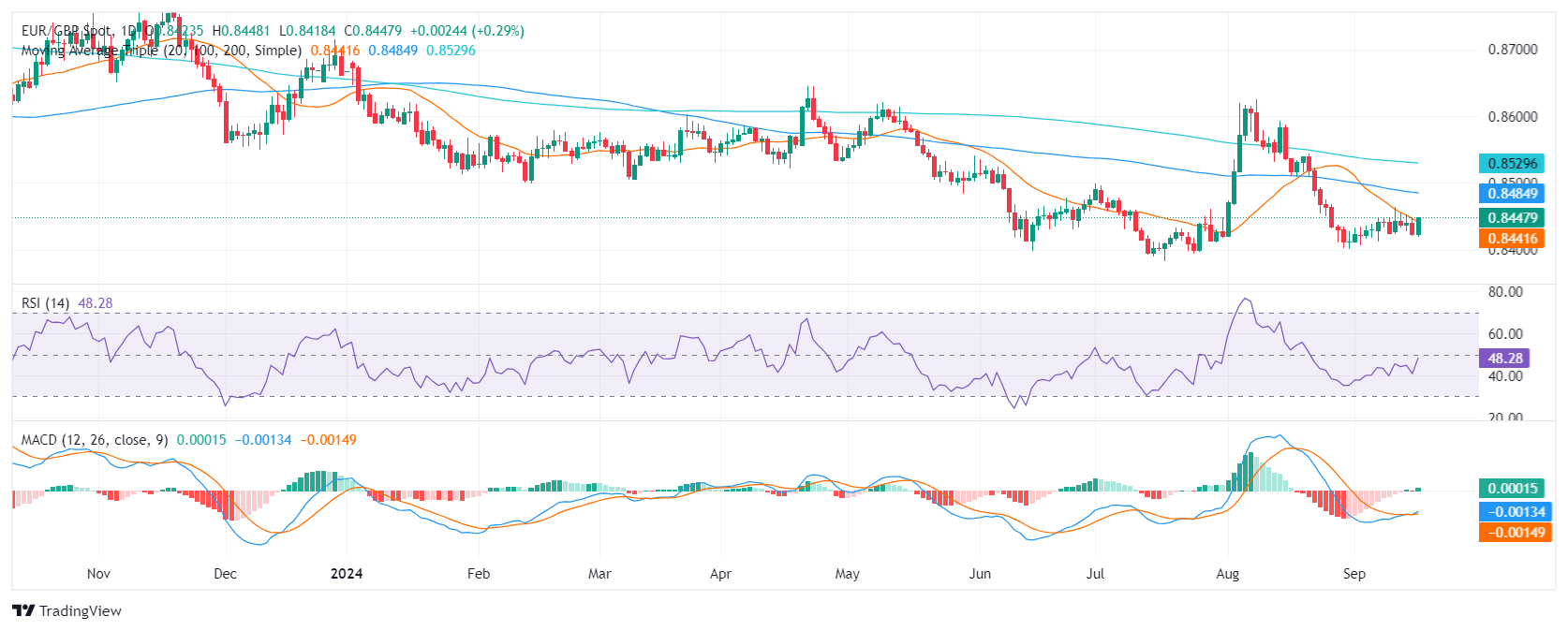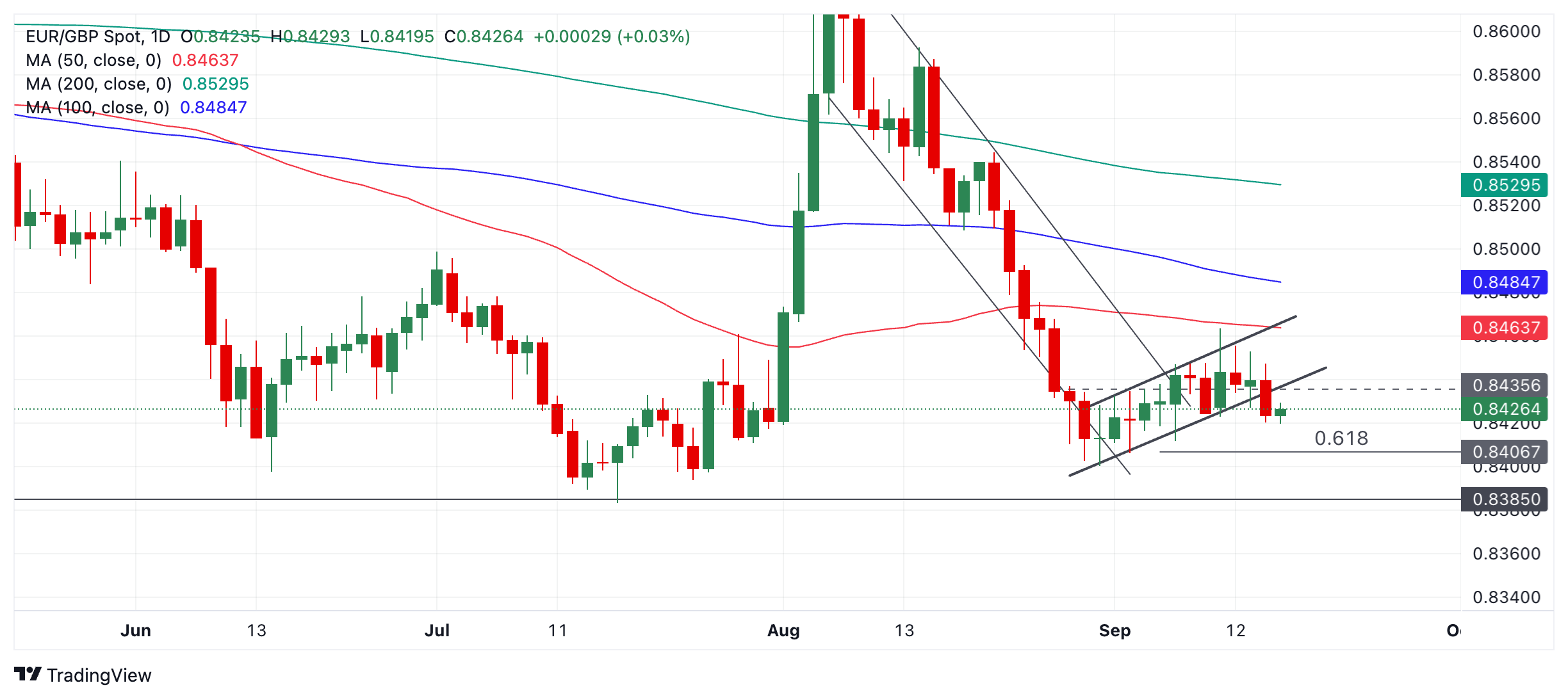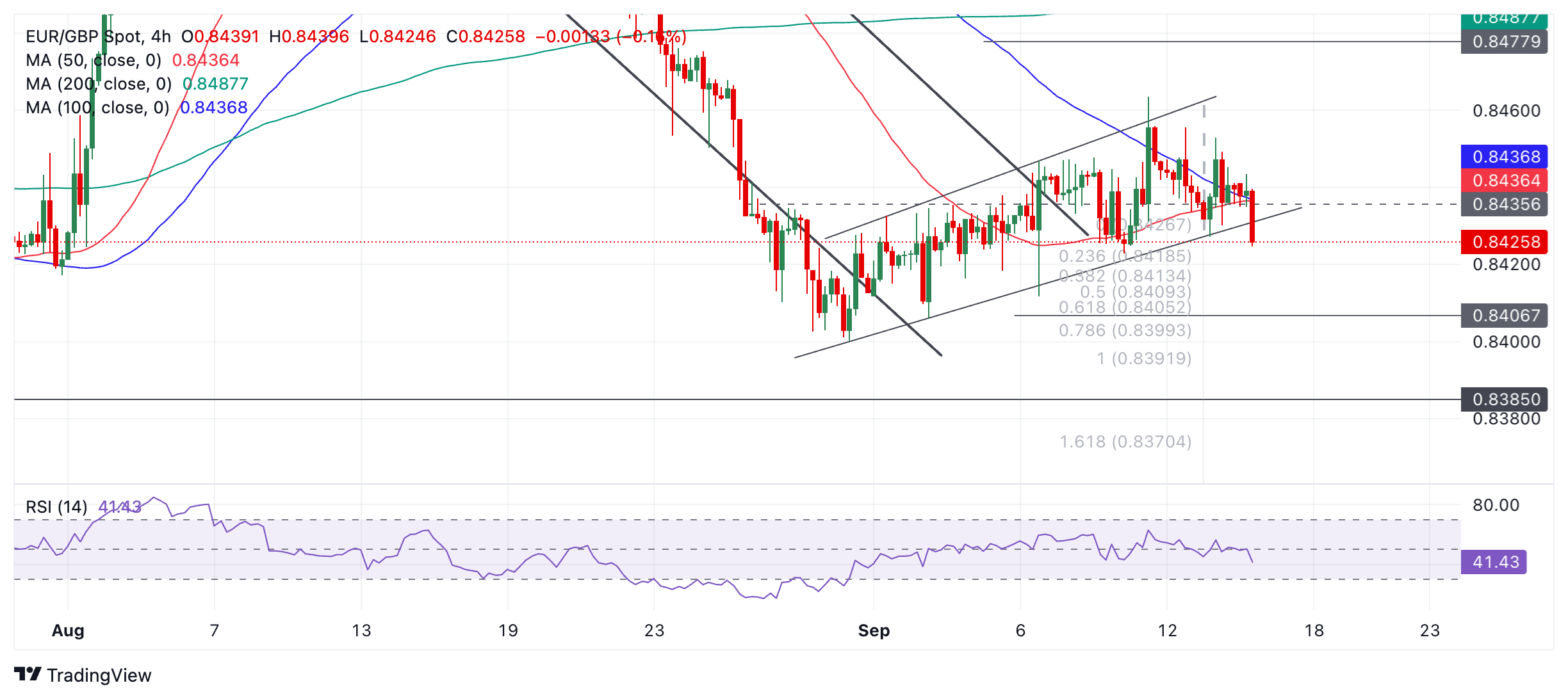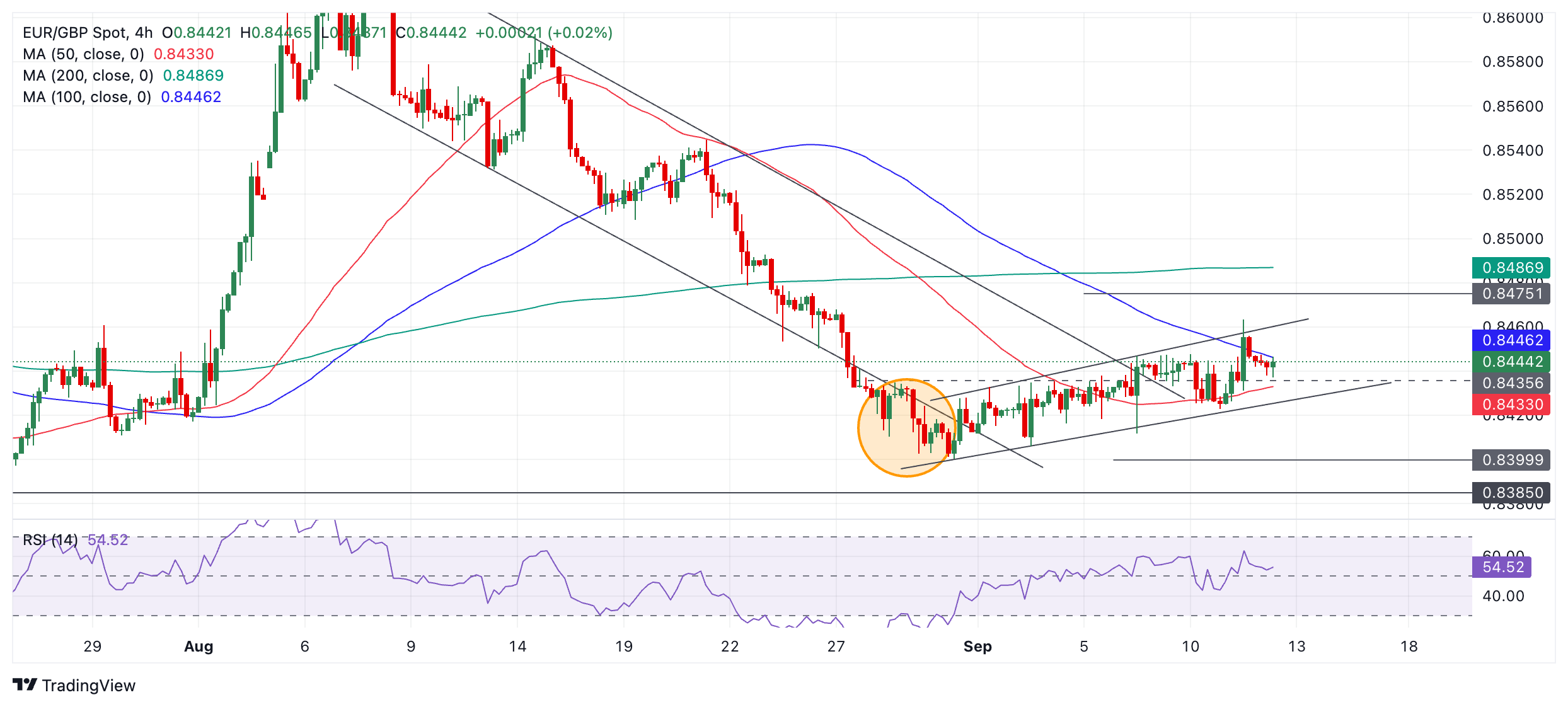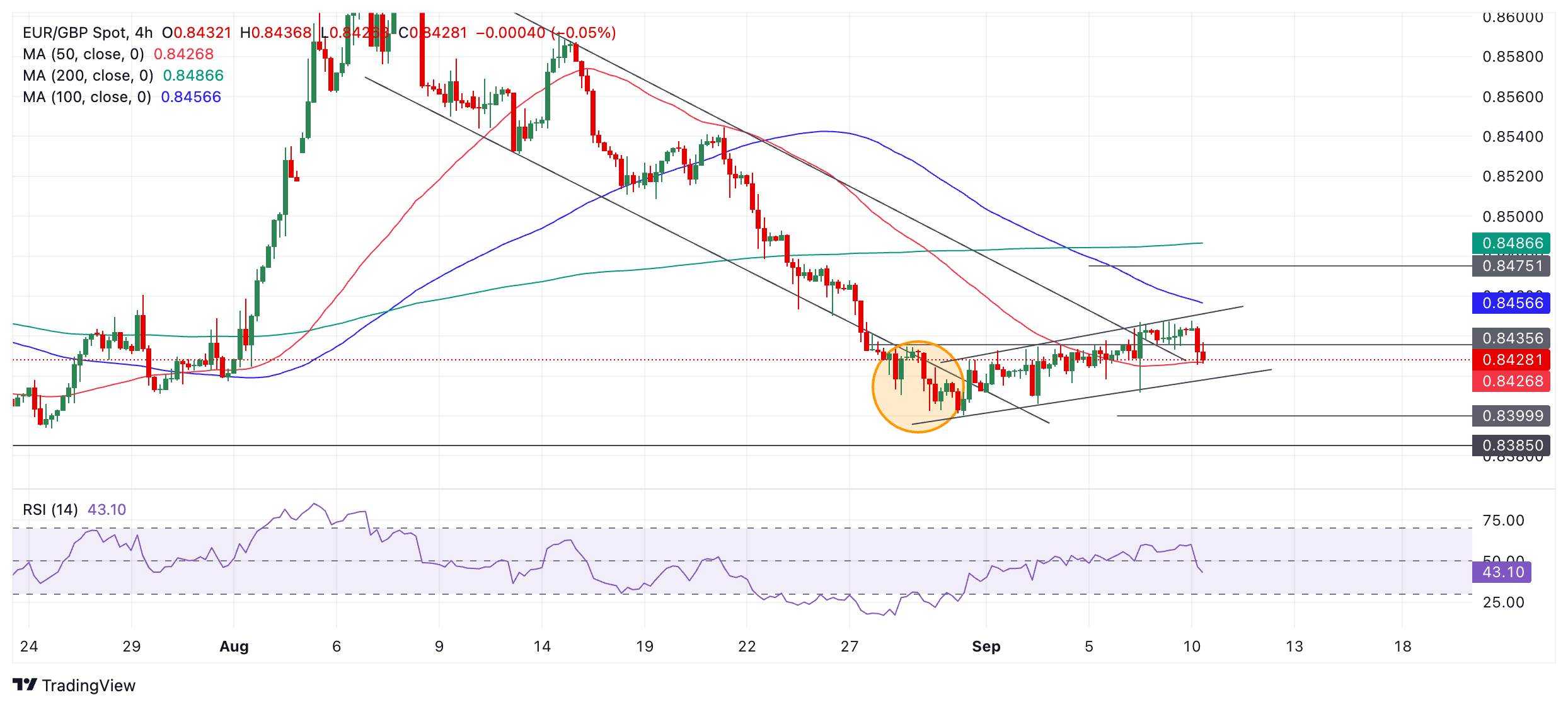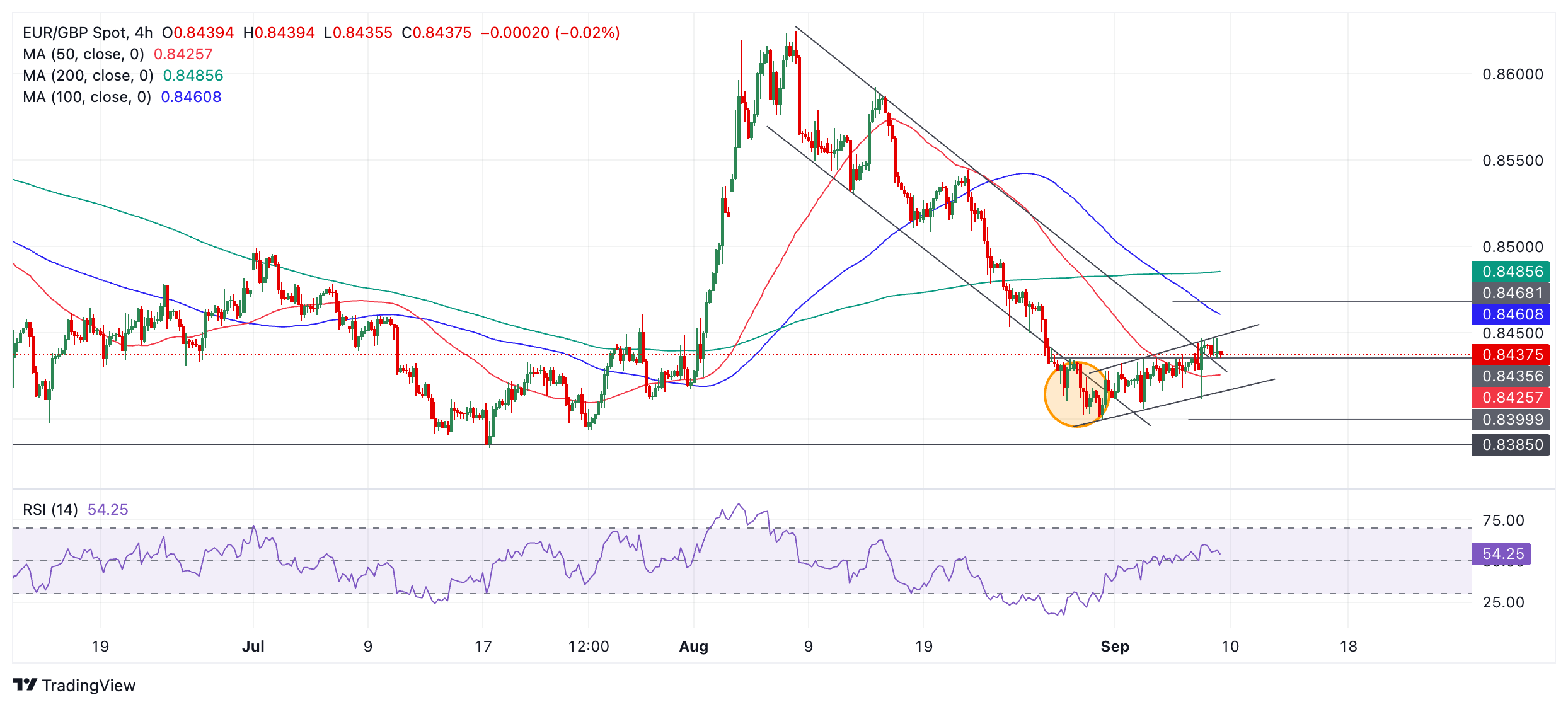- Analytics
- News and Tools
- Quotes
- Chart and quotes for EURGBP
CFD Trading Rate Euro vs Great Britain Pound (EURGBP)
| Date | Rate | Change |
|---|
Related news
-
18.09.2024 12:15EUR/GBP extends breakdown after release of UK inflation data
- UK inflation data released on Wednesday quashes hopes the BoE will cut interest rates on Thursday.
- Whilst this is bad news for UK mortgage holders the Pound Sterling rose on the news.
- Eurozone revisions of flash estimates to its inflation showed a downwards revision, weighing on the Euro.
EUR/GBP is trading lower on Thursday, exchanging hands in the 0.8420s as it continues falling after breaking out of the shallow channel it had been rising in since the end-of-August lows.
The pair is down by over a quarter of a percent on the day as the Euro (EUR) loses ground against the Pound Sterling (GBP) following the release of UK inflation data early Wednesday. The data wiped out any hope of the Bank of England (BoE) cutting interest rates at its meeting on Thursday. With interest rates expected to remain elevated Sterling gained because relatively higher interest rates attract foreign investors, resulting in higher inflows of capital.
Although headline inflation in the UK, as measured by the Consumer Price Index (CPI) remained unchanged at 2.2% in August YoY – as expected – core CPI rose above expectations, registering a 3.6% increase YoY. This was well above the 3.3% of July and the 3.5% expected. In addition, services inflation also rose, and this particular component of inflation has been a major reason holding back the BoE from cutting interest rates before.
“..but the rise in services inflation 5.2% to 5.6% suggests the Bank of England will almost certainly press the pause button on interest rate cuts on Thursday. We continue to expect the next 25 basis point rate cut to take place in November," said Ruth Gregory, Deputy Chief UK Economist at Capital Economics.
The Euro, meanwhile, experienced mild weakness after the Eurozone’s gauge of inflation, the Harmonized Index of Consumer Prices (HICP) was revised down to 0.1% MoM in August from a flash estimate of 0.2%, when no change was expected. Lower inflation suggests the European Central Bank (ECB) will be more likely to cut interest rates in the future, given its officially data-dependent stance. Lower interest rates are negative for currencies as they attract comparatively less inflows of foreign capital.
EUR/GBP may have lost further ground after European Central Bank (ECB) Governing Council member and Bank of France President, François Villeroy de Galhau, confirmed more cuts were on their way, saying that the “ECB is likely to continue to cut rates.”
His comments mark a change in tone and follow more cautious statements from colleagues. ECB Governing Council member Gediminas Šimkus said on Tuesday, “the likelihood of an October rate cut is very small.” His colleague ECB Chief Economist Philip Lane said on Monday that the ECB should retain optionality about the speed of policy adjustments, and added that wages were rising “as expected” and likely to “remain high and volatile” during the second half of 2024, indicating he expected inflation to remain relatively high over the period and therefore advocating a cautious approach to cutting interest rates.
-
18.09.2024 06:39EUR/GBP holds below 0.8450 as UK CPI inflation steadies at 2.2% YoY in August
- EUR/GBP weakens around 0.8445 in Wednesday’s early European session.
- The UK annual CPI climbed 2.2% in August vs. 2.2% expected.
- Investors will shift their focus to the Eurozone HICP inflation for August, which is due on Wednesday.
The EUR/GBP cross loses its recovery momentum near 0.8445 during the early European session on Wednesday. The Pound Sterling (GBP) edges higher after the UK inflation data. The attention will shift to the Eurozone Harmonized Index of Consumer Prices (HICP) data, wishes to you later in the day.
Data released by the Office for National Statistics showed on Wednesday that the UK CPI rose at an annual pace of 2.2% in August. The figure was in line with the market consensus and the previous reading of 2.2%. Meanwhile, core CPI, excluding volatile food and energy items, climbed 3.6% YoY in August versus 3.3% in July, hotter than the 3.5% expected. The GBP attracts some buyers in an immediate reaction to the UK CPI inflation data.
The Bank of England (BoE) interest rate decision will be in the spotlight on Thursday. The UK central bank is anticipated to keep rates on hold before adopting a more aggressive stance from November. The odds of another 25 basis points (bps) rate cut in September increased but remain relatively low nearly 35%, according to LSEG data.
On the Euro front, the European Central Bank (ECB) Governing Council member Martins Kazaks said on Monday that the central bank will ease monetary policy further, though it shouldn’t do so too hastily due to lingering inflation risks. Less dovish interest rate guidance from European Central Bank (ECB) officials might help limit the Euro’s losses against the GBP.
The Eurozone HICP inflation might offer some hints about the inflation trajectory in the Eurozone and influence the ECB about the next move. The HICP is estimated to show an increase of 2.2% YoY in August, while the core HICP is forecasted to show a rise of 2.8% in the same period.Inflation FAQs
Inflation measures the rise in the price of a representative basket of goods and services. Headline inflation is usually expressed as a percentage change on a month-on-month (MoM) and year-on-year (YoY) basis. Core inflation excludes more volatile elements such as food and fuel which can fluctuate because of geopolitical and seasonal factors. Core inflation is the figure economists focus on and is the level targeted by central banks, which are mandated to keep inflation at a manageable level, usually around 2%.
The Consumer Price Index (CPI) measures the change in prices of a basket of goods and services over a period of time. It is usually expressed as a percentage change on a month-on-month (MoM) and year-on-year (YoY) basis. Core CPI is the figure targeted by central banks as it excludes volatile food and fuel inputs. When Core CPI rises above 2% it usually results in higher interest rates and vice versa when it falls below 2%. Since higher interest rates are positive for a currency, higher inflation usually results in a stronger currency. The opposite is true when inflation falls.
Although it may seem counter-intuitive, high inflation in a country pushes up the value of its currency and vice versa for lower inflation. This is because the central bank will normally raise interest rates to combat the higher inflation, which attract more global capital inflows from investors looking for a lucrative place to park their money.
Formerly, Gold was the asset investors turned to in times of high inflation because it preserved its value, and whilst investors will often still buy Gold for its safe-haven properties in times of extreme market turmoil, this is not the case most of the time. This is because when inflation is high, central banks will put up interest rates to combat it. Higher interest rates are negative for Gold because they increase the opportunity-cost of holding Gold vis-a-vis an interest-bearing asset or placing the money in a cash deposit account. On the flipside, lower inflation tends to be positive for Gold as it brings interest rates down, making the bright metal a more viable investment alternative.
-
17.09.2024 16:10EUR/GBP Price Analysis: Bulls gather steam, aim for critical resistance
- The EUR/GBP rose to 0.8450 aiming for the 20-day SMA
- The RSI and MACD are projecting that buying pressure is increasing.
- If the buyers regain the 20-day SMA, the outlook will improve.
In Tuesday's session, the EUR/GBP rose by 0.28% to 0.8450 and extended its sideways trading range tracking the narrow-range movements of the past sessions. A break above the 20-day Simple Moving Average (SMA) which convergences at 0.8450, would confirm a break of the side-ways movements.
The Relative Strength Index (RSI), currently at 50, indicates that the pair is in neutral territory, while the RSI slope is rising sharply, suggesting that buying pressure is recovering. The Moving Average Convergence Divergence (MACD) shows a green histogram with rising bars, revealing that buying pressure is increasing. Combining these technical indicators suggests that bulls are regaining some control.
EUR/GBP daily chart
The EUR/GBP pair has been consolidating within a narrow range for the last seven sessions, with little upward or downward momentum. Nonetheless, the pair is trading slightly higher at 0.8450 and has traded primarily within the 0.8420-0.8460 range. If the pair breaks above the immediate resistance level of 0.8460, it could potentially target 0.8480 and 0.8500. Conversely, a break below 0.8420 could open up further downside potential below 0.8400 and 0.8380.
-
17.09.2024 11:01EUR/GBP Price Forecast: Breakdown from channel could follow-through lower
- EUR/GBP has broken out of a channel and closed below the lower channel line.
- It will probably continue falling to bearish targets.
EUR/GBP has broken out of the underside of a shallow rising channel. It has closed below the channel line suggesting the breakout will probably follow-through and go lower, possibly to a target at 0.8406.
EUR/GBP Daily Chart
It is possible the bearish bias evident during the steep fall in August is reaserting itself. A break below 0.8419 would provide confirmation of further downside toward a target at 0.8406, the 0.618 Fib extension of the height of the rising channel lower. Below that it is possible prices could fall to support at 0.8385.
Alternatively, it is still possible – though unlikely – that the break proves false. If so, price could recover back inside the shallow rising channel and extend, with circa 0.8460 as a possible upside target thereafter.
-
17.09.2024 06:39EUR/GBP trades flat above 0.8400, focus on UK/ Eurozone August inflation data
- EUR/GBP trades on a flat note near 0.8420 in Tuesday’s Asian session.
- ECB’s Kazaks said the central bank will ease monetary policy further, though it shouldn’t do so too hastily.
- The BoE is anticipated to leave the interest rate unchanged at its September meeting on Thursday.
The EUR/GBP cross remains steady around 0.8420 on Tuesday during the early European trading hours. The European Central Bank (ECB) rate cut and lower growth forecasts might further weigh on the Euro (EUR) in the near term. Investors await the UK and Eurozone August inflation data on Wednesday for fresh impetus. On Thursday, the Bank of England's (BoE) interest rate decision will be in the spotlight.
The ECB decided to reduce its key deposit rate a quarter point to 3.5% last week as inflation eases. It was the second cut, after the first move in June. ECB President stated during the press conference that the interest rate path ahead was "not pre-determined” and the central bank shall be "data dependent.” On Monday, ECB Governing Council member Martins Kazaks said that the central bank will ease monetary policy further, though it shouldn’t do so too hastily due to lingering inflation risks.
The release of the Eurozone Harmonized Index of Consumer Prices (HICP) on Wednesday could offer some hints about the inflation trajectory in the Eurozone and might influence the ECB about the next move. The headline and core inflation are projected to remain unchanged on a yearly basis in August. However, the hotter-than-expected outcome might prompt the ECB to slow its interest rate cut pace, which might lift the shared currency.
On the other hand, the Bank of England (BoE) is expected to hold an interest rate at 5.0% on Thursday. However, cooling wage growth might trigger the UK central bank to cut at least once more by the end of the year. “The tone of the August meeting and subsequent speeches have made it abundantly clear that officials don’t want markets running away with the idea that this is going to be a rapid easing cycle,” said James Smith, an economist at ING.
On Wednesday, the UK Consumer Price Index (CPI) inflation data will be released. The CPI is expected to show an increase of 2.2% YoY in August, while the core CPI is estimated to rise 3.5% in the same reported period. The softer reading could prompt the BoE to consider another cut in November.
BoE FAQs
The Bank of England (BoE) decides monetary policy for the United Kingdom. Its primary goal is to achieve ‘price stability’, or a steady inflation rate of 2%. Its tool for achieving this is via the adjustment of base lending rates. The BoE sets the rate at which it lends to commercial banks and banks lend to each other, determining the level of interest rates in the economy overall. This also impacts the value of the Pound Sterling (GBP).
When inflation is above the Bank of England’s target it responds by raising interest rates, making it more expensive for people and businesses to access credit. This is positive for the Pound Sterling because higher interest rates make the UK a more attractive place for global investors to park their money. When inflation falls below target, it is a sign economic growth is slowing, and the BoE will consider lowering interest rates to cheapen credit in the hope businesses will borrow to invest in growth-generating projects – a negative for the Pound Sterling.
In extreme situations, the Bank of England can enact a policy called Quantitative Easing (QE). QE is the process by which the BoE substantially increases the flow of credit in a stuck financial system. QE is a last resort policy when lowering interest rates will not achieve the necessary result. The process of QE involves the BoE printing money to buy assets – usually government or AAA-rated corporate bonds – from banks and other financial institutions. QE usually results in a weaker Pound Sterling.
Quantitative tightening (QT) is the reverse of QE, enacted when the economy is strengthening and inflation starts rising. Whilst in QE the Bank of England (BoE) purchases government and corporate bonds from financial institutions to encourage them to lend; in QT, the BoE stops buying more bonds, and stops reinvesting the principal maturing on the bonds it already holds. It is usually positive for the Pound Sterling.
-
16.09.2024 15:56EUR/GBP Price Analysis: Bearish momentum intensifies, buyers rejected by the 20-day SMA
- The EUR/GBP pair extended its losses on Monday, declining to 0.8425.
- Technical indicators, including the RSI and MACD, suggest that selling pressure is increasing.
- Bulls failed to conquer the 20-day SMA which paved the way for the downside.
In Monday's session the EUR/GBP and declined by 0.15% to 0.8425. The pair has been trading sideways in a narrow range over the past sessions, with no clear directional bias. However, the latest price action suggests that selling pressure is increasing after the 20-day Simple Moving Average (SMA) rejected the buyers at 0.8445.
The Relative Strength Index (RSI) is currently at 43 and its slope is declining sharply, suggesting that selling pressure is rising. The Moving Average Convergence Divergence (MACD) is flat with a green histogram, indicating that buying pressure is flat. The overall outlook is mixed, with the RSI suggesting that selling pressure is rising and the MACD suggesting that buying pressure is flat leaving the cross exposed to further declines.
EUR/GBP daily chart
The EUR/GBP pair has been consolidating within a narrow range for the past few trading sessions, fluctuating between 0.8425 and 0.8450. This consolidation is indicative of a lack of clear directional bias in the near term. If the pair manages to break below the immediate support level of 0.8425, it could potentially target 0.8410 and 0.8400. Conversely, a break above 0.8445 (20-day SMA) could open up further upside potential above 0.8470.
-
16.09.2024 10:57EUR/GBP Price Forecast: A bearish breakout from a shallow rising channel
- EUR/GBP is breaking out below the lower channel of a shallow rising channel.
- If the break holds the pair will probably continue falling.
EUR/GBP pierces below the lower channel line of its rising channel in a breakout attempt lower.
It is possible the bearish bias evident during the steep fall in August is reaserting itself. A close below 0.8423 (September 10 low) would pave the way for further weakness to a downside target at 0.8406, the 0.618 Fib extension lower. Below that lies support at 0.8385.
EUR/GBP 4-hour Chart
Alternatively, if the break proves false there is a chance the shallow rising channel could extend, with circa 0.8460 as a possible upside target.
A close above the 0.8464 high (September 11 high) would be required to confirm an upside breakout from the channel. Such a move might reach about 0.8477, the 0.618 Fibonacci (Fib) extension if the height of the channel extrapolated higher.
-
16.09.2024 06:06EUR/GBP loses momentum below 0.8450 ahead of Eurozone, UK CPI data
- EUR/GBP trades softer around 0.8435 in Monday’s early European session.
- ECB cut its rate by 25 bps last week, but the bank offered no indications of what its next move would be.
- The BoE is anticipated to hold the interest rate at 5.0% on Thursday.
The EUR/GBP cross edges lower to near 0.8435 during the early European session on Monday. The upside of the Euro (EUR) might be limited after the European Central Bank’s (ECB) interest rate decision last week. The attention will shift to the UK and Eurozone August inflation data on Wednesday ahead of the Bank of England (BoE) interest rate decision.
The ECB delivered a quarter-point interest rate cut last week, marking its second reduction to the deposit rate this year. Furthermore, the central bank revised its growth forecast for 2024 to 0.8% from an earlier projection of 0.9% due to “weaker contribution from domestic demand over the next few quarters.” The ECB rate cut and lower growth forecasts might undermine the shared currency in the near term.
The ECB Governing Council member Gabriel Makhlouf noted on Friday that the central bank continues to operate in a "highly uncertain environment" and will remain data-dependent when it comes to making future monetary policy decisions.On the GBP’s front, the BoE rate decision will be the highlight on Thursday, with expectations that it will leave its policy rate unchanged at 5.0% in the September meeting. Ahead of the UK key event, the UK Consumer Price Index (CPI) inflation data will be published, which is expected to show an increase of 2.2% YoY in August. The softer reading could prompt the BoE to consider another cut in November.
ECB FAQs
The European Central Bank (ECB) in Frankfurt, Germany, is the reserve bank for the Eurozone. The ECB sets interest rates and manages monetary policy for the region. The ECB primary mandate is to maintain price stability, which means keeping inflation at around 2%. Its primary tool for achieving this is by raising or lowering interest rates. Relatively high interest rates will usually result in a stronger Euro and vice versa. The ECB Governing Council makes monetary policy decisions at meetings held eight times a year. Decisions are made by heads of the Eurozone national banks and six permanent members, including the President of the ECB, Christine Lagarde.
In extreme situations, the European Central Bank can enact a policy tool called Quantitative Easing. QE is the process by which the ECB prints Euros and uses them to buy assets – usually government or corporate bonds – from banks and other financial institutions. QE usually results in a weaker Euro. QE is a last resort when simply lowering interest rates is unlikely to achieve the objective of price stability. The ECB used it during the Great Financial Crisis in 2009-11, in 2015 when inflation remained stubbornly low, as well as during the covid pandemic.
Quantitative tightening (QT) is the reverse of QE. It is undertaken after QE when an economic recovery is underway and inflation starts rising. Whilst in QE the European Central Bank (ECB) purchases government and corporate bonds from financial institutions to provide them with liquidity, in QT the ECB stops buying more bonds, and stops reinvesting the principal maturing on the bonds it already holds. It is usually positive (or bullish) for the Euro.
-
13.09.2024 15:50EUR/GBP Price Analysis: Selling pressure resumes and buyers give up the 20-day SMA
- The negative outlook remains, RSI and MACD suggest bearish momentum.
- The multiple rejections by the 20-day SMA suggest that the buyer’s traction is too weak.
- A break from above mentioned average would improve the outlook.
In Friday's session, the EUR/GBP pair fell slightly by 0.15% to 0.8435, showcasing a negative technical outlook. Bears continue to drive the pair lower, reinforcing the overall bearish trend while buyers continue to struggle to conquer the 20-day Simple Moving Average..
The Relative Strength Index (RSI) is currently at 44, within negative territory, with a mildly declining slope, signifying weakening buying momentum. The Moving Average Convergence Divergence (MACD) histogram is displaying decreasing red bars, indicating a decline in selling pressure. This mixed outlook suggests that the selling forces are steady while buying force is losing momentum.
The EUR/GBP pair has been consolidating within a narrow range for the past few trading sessions, fluctuating between 0.8425 and 0.8450. This consolidation is indicative of a lack of clear directional bias in the near term. If the pair manages to break below the immediate support level of 0.8425, it could potentially target 0.8410 and 0.8400. Conversely, a break above 0.8450 (20-day SMA)could open up further upside potential above 0.8470.
EUR/GBP Daily chart
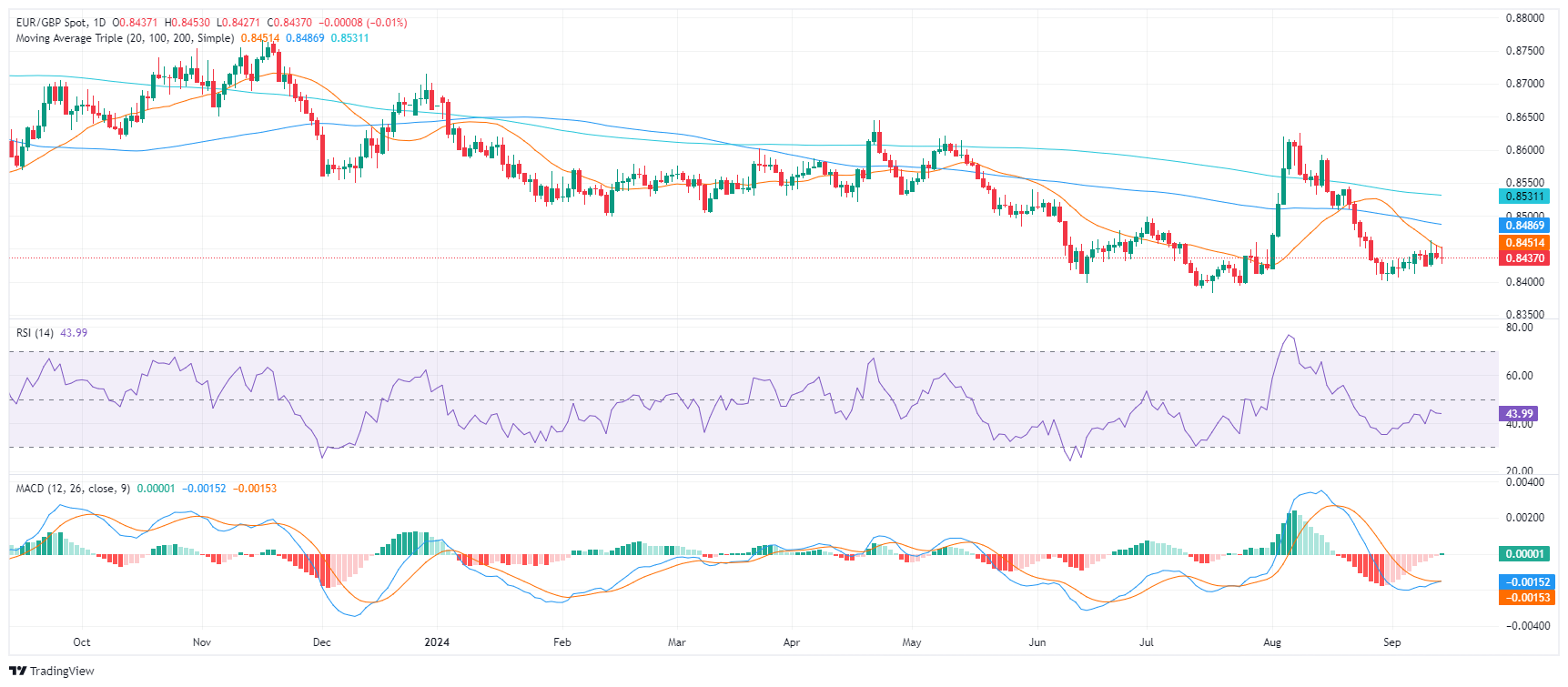
-
13.09.2024 12:52EUR/GBP Price Analysis: Bounces off lower channel line and continues modest gains
- EUR/GBP has rebounded after touching the lower channel line of its rising channel.
- The chart suggests a mild bullish bias as price slowly makes steps higher.
EUR/GBP bounces off the lower channel line of its shallow rising channel and pushes higher.
Price continues to respect the confines of the recovery channel which began at the August 30 lows. Little by little it climbs higher suggesting a new short-term uptrend is taking root.
EUR/GBP 4-hour Chart
The Moving Average Convergence Divergence (MACD) momentum indicator stays above the zero line indicating a mild bullishness to price dynamics.
A close above the 0.8464 high (September 11 high) would be required to confirm an upside breakout from the channel. Such a move would likely reach about 0.8477, the 0.618 Fibonacci (Fib) extension if the height of the channel extrapolated higher.
Bullish signs now marginally outweigh bearish. For starters EUR/GBP keeps rising within a bullish channel, secondly it has now worked its way through the previous falling channel, and finally the exhaustion break during August (orange shaded circle) – when it accelerated to the downside – is a bullish reversal sign.
The main bearish sign is the relative shallowness of the rising channel in comparison to the much steeper previous bear move.
A close below 0.8423 (September 10 low) would pave the way for further weakness to a downside target at 0.8406, the 0.618 Fib extension lower.
-
13.09.2024 07:32EUR/GBP trades around 0.8450 after paring losses, assessing ECB policymakers' comments
- EUR/GBP recovers its daily losses following the remarks from ECB Policymakers.
- ECB Governing Council member Bostjan Vasle stated that the central bank is not committed to any predetermined rate path.
- BoE is expected to deliver additional rate cuts following a slowdown in UK wage growth and flat GDP data.
EUR/GBP recovers intraday losses, trading around 0.8430 during the early European hours on Friday. However, the EUR/GBP cross faced challenges following the European Central Bank’s (ECB) interest rate decision on Thursday.
The ECB reduced the Main Refinancing Operations Rate to 3.65% with a 60 basis points (bps) rate cut, exceeding the market expectations of a 25 bps cut. Additionally, in an interview with Deutschlandfunk early Friday, ECB policymaker and Bundesbank President Joachim Nagel mentioned that "core inflation is also moving in the right direction." Nagel expects the inflation goal to be achieved at the end of next year.
ECB Governing Council member Bostjan Vasle stated on Friday that "we are not committed to any predetermined rate path." Vasle also mentioned that inflation will largely be driven by core inflation and services. Meanwhile, ECB policymaker Olli Rehn emphasized that future policy decisions will continue to be based on an assessment of the inflation outlook, with current uncertainties highlighting the importance of relying on fresh economic data.
Traders are anticipating additional interest rate cuts by the Bank of England (BoE), particularly after this week's data indicated a slowdown in UK wage growth and a flat GDP print for the second consecutive month in July. These economic signals have reinforced expectations of more easing measures by the BoE.
Friday’s Eurozone Industrial Production is anticipated to decrease by 0.3% MoM in July, following a previous 0.1% decline. Meanwhile, the annual data is expected to show a 2.7% decline, an improvement from the previous 3.9% drop. On the UK front, Consumer Inflation Expectations will be eyed.
Interest rates FAQs
Interest rates are charged by financial institutions on loans to borrowers and are paid as interest to savers and depositors. They are influenced by base lending rates, which are set by central banks in response to changes in the economy. Central banks normally have a mandate to ensure price stability, which in most cases means targeting a core inflation rate of around 2%. If inflation falls below target the central bank may cut base lending rates, with a view to stimulating lending and boosting the economy. If inflation rises substantially above 2% it normally results in the central bank raising base lending rates in an attempt to lower inflation.
Higher interest rates generally help strengthen a country’s currency as they make it a more attractive place for global investors to park their money.
Higher interest rates overall weigh on the price of Gold because they increase the opportunity cost of holding Gold instead of investing in an interest-bearing asset or placing cash in the bank. If interest rates are high that usually pushes up the price of the US Dollar (USD), and since Gold is priced in Dollars, this has the effect of lowering the price of Gold.
The Fed funds rate is the overnight rate at which US banks lend to each other. It is the oft-quoted headline rate set by the Federal Reserve at its FOMC meetings. It is set as a range, for example 4.75%-5.00%, though the upper limit (in that case 5.00%) is the quoted figure. Market expectations for future Fed funds rate are tracked by the CME FedWatch tool, which shapes how many financial markets behave in anticipation of future Federal Reserve monetary policy decisions.
-
12.09.2024 16:03EUR/GBP Price Analysis: Bears ease their grip, buyers still remain weak
- Overall bearish outlook remains, RSI and MACD indicate short-term mixed momentum.
- Selling pressure is declining, indicated by decreasing red MACD bars.
- The 20-day SMA continues to be a strong resistance.
In Thursday's session, the EUR/GBP retreated and stands flat around 0.8440, showcasing a mixed technical outlook. Bears appear to be moderating their short-term bearish pressure, but the overall technical outlook remains bearish.
The Relative Strength Index (RSI) is currently at 44, within negative territory, and exhibits a flat slope, signifying a gradual recovery in buying momentum. The Moving Average Convergence Divergence (MACD) histogram is displaying decreasing red bars, indicating a decline in selling pressure. This mixed outlook suggests that the buying and selling forces are relatively balanced at the moment.
EUR/GBP daily chart
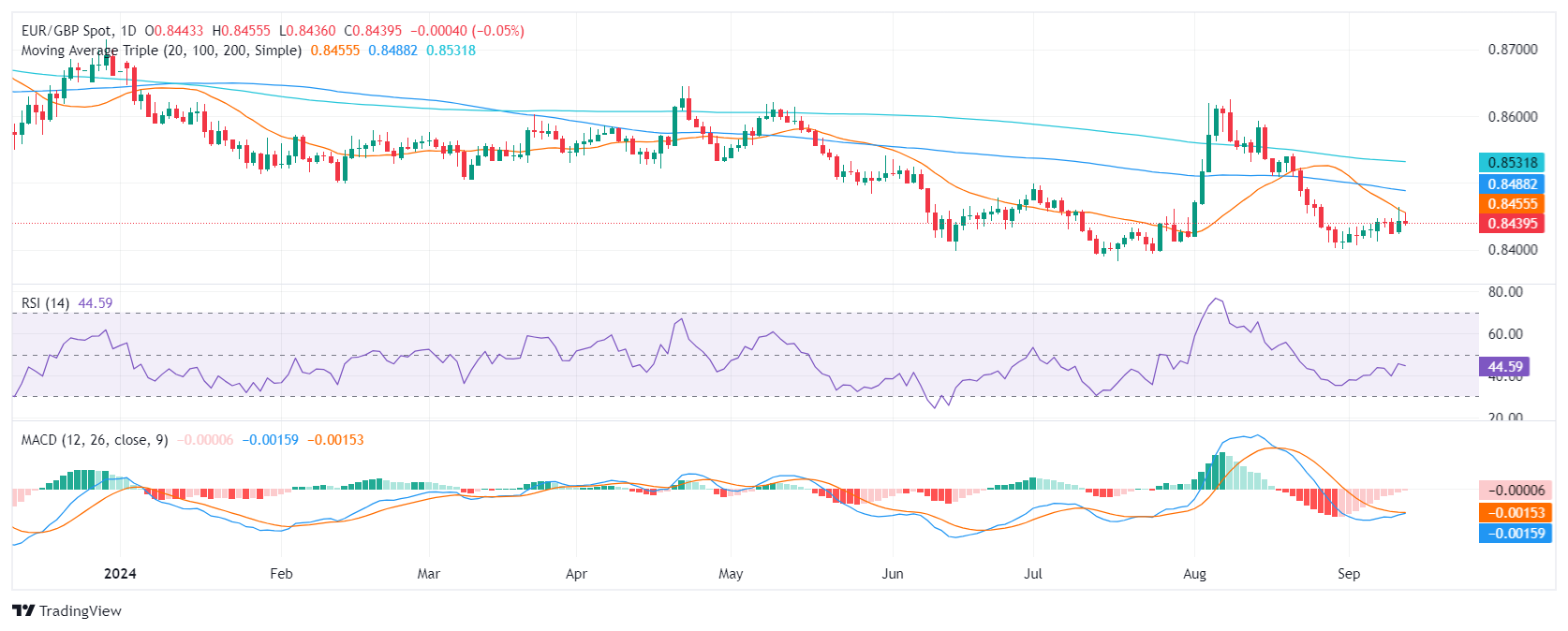
The EUR/GBP pair has been consolidating within a narrow range for the past few trading sessions, fluctuating between 0.8420 and 0.8450. This consolidation is indicative of a lack of clear directional bias in the near term. If the pair manages to break above the immediate resistance level of 0.8450 (20-day SMA), it could potentially target 0.8460 and 0.8470. Conversely, a break below 0.8420 could open up further downside potential below 08400.
-
12.09.2024 11:29EUR/GBP Price Forecast: Shallow rising channel extends
- EUR/GBP continues rising in a shallow channel.
- It will probably extend unless there is a breakout one way or another.
EUR/GBP is extending a shallow ascending recovery channel that began at the August 30 lows. The overall short-term trend is unclear – both positive and negative signs complicate the picture.
EUR/GBP 4-hour Chart
EUR/GBP continues respecting the guard rails of the channel and in the absence of a breakout in either direction the it will probably continue climbing steadily higher.
A close above the 0.8464 high (September 11 high) would be required to confirm an upside breakout from the channel. Such a move could be expected to reach roughly 0.8477, the 0.618 Fibonacci (Fib) extension if the height of the channel extrapolated higher.
Alternatively a close below 0.8423 (September 10 low) would pave the way for further weakness to a downside target at 0.8406, the 0.618 Fib extension lower.
Bullish signs are that price is in a rising channel, that it has broken all the way through the previous falling channel and the exhaustion break during August (orange shaded circle) when it accelerated to the downside, which is a reversal sign.
The main bearish sign is the relative shallowness of the rising channel in comparison to the much steeper previous bear move.
-
11.09.2024 15:58EUR/GBP Price Analysis: Bulls make a stride and challenge the 20-day SMA
- Technical indicators suggest a shift in momentum toward positive territory
- RSI rises near 50, indicating a recovery in buying pressure.
- MACD continues printing decreasing red bars.
In Wednesday's session, when the EUR/GBP broke out and saw 0.40% gains to rise near 0.8450. While bulls made a huge step, they still have more work to do to confirm a recovery.
The Relative Strength Index (RSI) has moved back towards the 50 midpoint, signaling that buying pressure is recovering. This is supported by the flattening of the Moving Average Convergence Divergence (MACD) histogram, with the red bars decreasing and the histogram moving closer to the zero line. This suggests a potential shift in momentum toward positive territory.
However, the overall outlook remains cautious as the choppy and price action in recent candles suggests consolidation for the pair. While the pair has been holding above the 0.8400 support level, the next resistance level to watch is 0.8460 at the 20-day Simple Moving Average (SMA) and a break above could confirm a recovery.
EUR/GBP daily chart
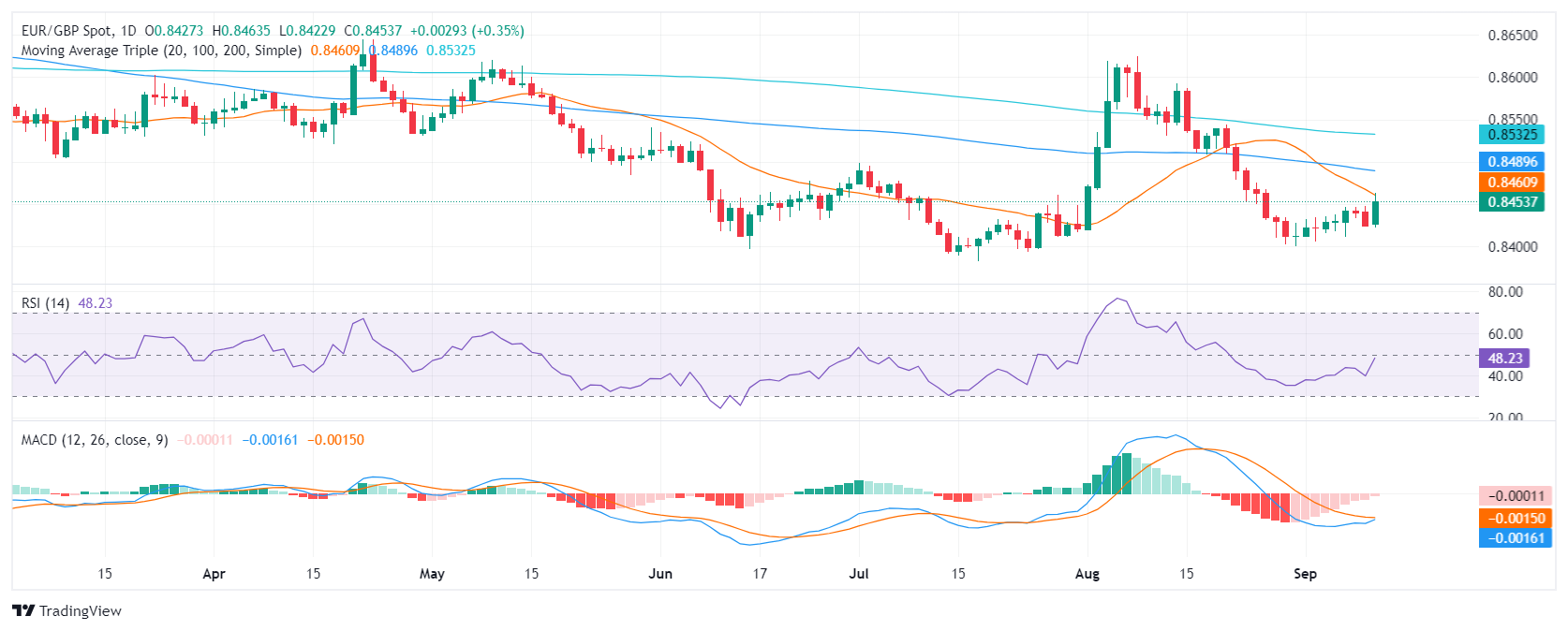
-
10.09.2024 15:45EUR/GBP Price Analysis: Bearish outlook persists, pair continues sideways trading
- A bearish outlook remains, with RSI below 50 and MACD.
- Selling pressure is declining, indicated by decreasing red MACD bars.
In Tuesday's session, the EUR/GBP pair mildly rose to 0.8440 and is showing that the technical outlook remains mixed. Bears seem to be taking a breather after shedding more than 1% in August, but the overall technical outlook is still pointing at a bearish market.
The Relative Strength Index (RSI) remains in negative territory, around 44, with a mildly neutral slope, signaling flattening bearish momentum. The Moving Average Convergence Divergence (MACD) prints decreasing red bars, further reinforcing the flattening bearish traction.
The EUR/GBP pair continues consolidating above 0.8400, which serves as immediate support following the sharp declines in August. Resistance is found at 0.8440, and a break above this level could lead to further gains towards 0.8450 and 0.8470.
EUR/GBP daily chart
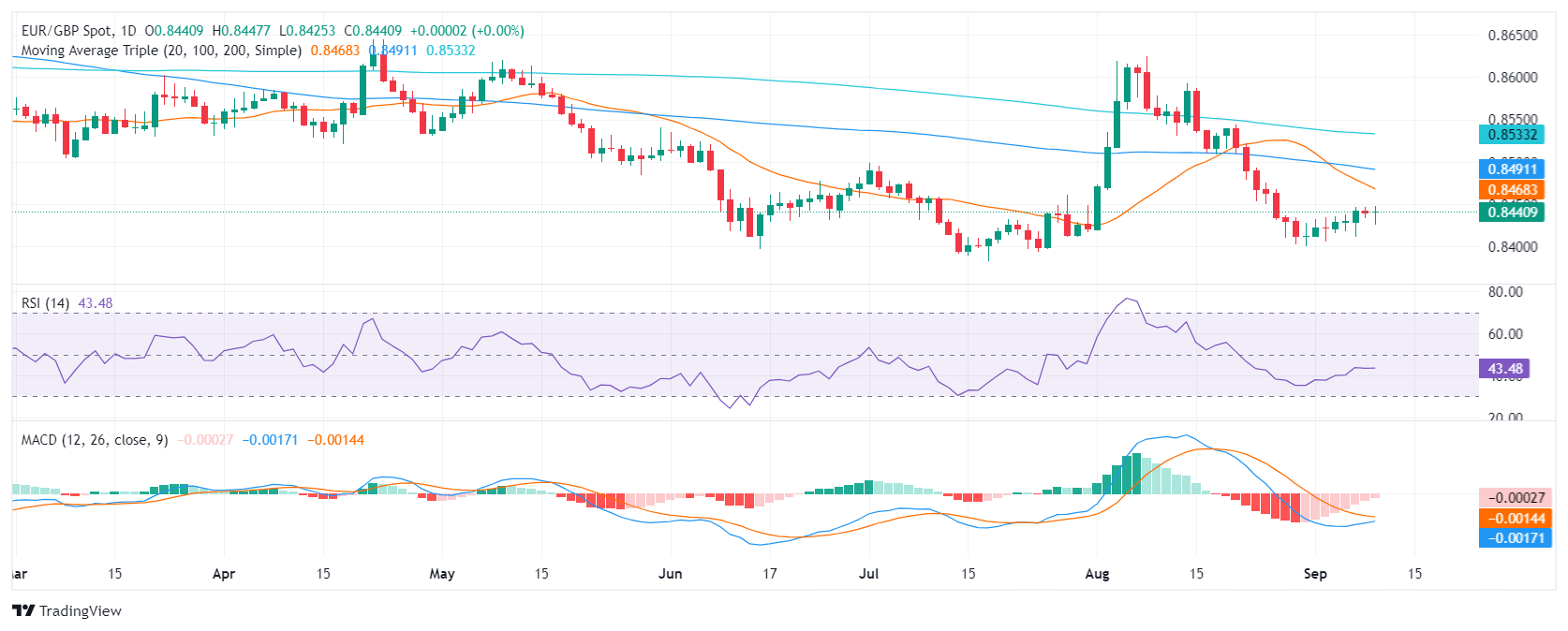
-
10.09.2024 11:45EUR/GBP: Break below 0.8400 to lead towards 0.8380 – Société Generale
EUR/GBP decline has stalled after forming interim trough near 0.8400 recently, Société Generale FX strategists note.
A fall towards 0.8350/0.8340 is possible
“Daily MACD has been posting positive divergence denoting receding downward momentum, but signals of a meaningful rebound are not yet visible. The 50-DMA near 0.8465 is first layer of resistance; this must be overcome to confirm a larger bounce. Inability could mean risk of deeper pullback.”
“Break below 0.8400 can result in next leg of down move towards 0.8380 and perhaps even towards next projections at 0.8350/0.8340.”
-
10.09.2024 11:11EUR/GBP Price Analysis: Falling within shallow ascending channel
- EUR/GBP is declining within an ascending channel that has been rising since the end of August.
- The short-term trend is unclear although price continues respecting the boundaries of the channel.
EUR/GBP is falling within a shallow ascending recovery channel that began at the August 30 lows and the overall short-term trend is unclear.
The pair recently touched the top of the channel before pulling back down to the level of the 50-period Simple Moving Average (SMA).
EUR/GBP 4-hour Chart
EUR/GBP is respecting the guard rails of the channel and it will probably find support at the lower channel line at roughly 0.8420 before rotating higher again and extending the channel steadily higher.
The medium-term trend is probably still bearish, however, suggesting a risk of price breaking out lower.
A break below 0.8406 (September 3 low) would pave the way for further weakness to a downside target at 0.8385 (July 17 lows).
The break above the 50-period SMA was a bullish sign as was the breakout from the falling channel during August (orange shaded circle) when it accelerated to the downside. This could have been an exhaustion break. If so, it would be a bullish sign as these patterns usually happen at the end of trends and are a sign of reversal.
A clear break above the top of the shallow rising channel at roughly 0.8455 would be required to confirm a bullish reversal. Such a move could be expected to reach 0.8470-80 as an initial target zone.
-
10.09.2024 08:50EUR/GBP treads water near 0.8450 following the releases of German inflation, UK labor data
- EUR/GBP remains subdued following the inflation data release from Germany.
- German Harmonized Index of Consumer Prices maintained a 2.0% YoY increase in August, as expected.
- The ILO UK Unemployment Rate eased to 4.1% in the three months leading up to July, down from 4.2% in June.
EUR/GBP depreciates for the second successive session, trading around 0.8440 during Tuesday’s European hours. The Euro faces challenges against the Pound Sterling (GBP) following the inflation data from Germany.
Germany's Harmonized Index of Consumer Prices (HICP) maintained a 2.0% year-on-year increase in August, in line with expectations. The monthly index showed a steady decline of 0.2%, also as forecasted. Similarly, the Consumer Price Index (CPI) remained stable at 1.9% year-on-year in August, meeting market expectations.
The recent headline inflation from the Eurozone remains near 2%, coupled with mixed Gross Domestic Product (GDP) data has reinforced expectations of a potential rate cut by the European Central Bank (ECB) at upcoming Thursday's policy meeting.
The Pound Sterling receives support from the mixed employment data from the United Kingdom (UK). ILO Unemployment Rate eased to 4.1% in the three months to July, following June’s 4.2% print, the data published by the Office for National Statistics (ONS).
UK Claimant Count Change showed that the change in the number of unemployed people fell to 23.7K in August, falling short of the market expectations of 95.5K and the previous 102.3K readings. Average Earnings Including Bonus (3Mo/Yr) came in at 4.0% in July, against the expected 4.1% and prior 4.6% readings.
Bank of England (BoE) policymakers remain concerned about persistent inflation, particularly within the services sector. A slowdown in wage growth would ease these concerns and likely increase market speculation about potential interest rate cuts by the BoE in September. The focus now turns to UK GDP numbers due on Wednesday.
Inflation FAQs
Inflation measures the rise in the price of a representative basket of goods and services. Headline inflation is usually expressed as a percentage change on a month-on-month (MoM) and year-on-year (YoY) basis. Core inflation excludes more volatile elements such as food and fuel which can fluctuate because of geopolitical and seasonal factors. Core inflation is the figure economists focus on and is the level targeted by central banks, which are mandated to keep inflation at a manageable level, usually around 2%.
The Consumer Price Index (CPI) measures the change in prices of a basket of goods and services over a period of time. It is usually expressed as a percentage change on a month-on-month (MoM) and year-on-year (YoY) basis. Core CPI is the figure targeted by central banks as it excludes volatile food and fuel inputs. When Core CPI rises above 2% it usually results in higher interest rates and vice versa when it falls below 2%. Since higher interest rates are positive for a currency, higher inflation usually results in a stronger currency. The opposite is true when inflation falls.
Although it may seem counter-intuitive, high inflation in a country pushes up the value of its currency and vice versa for lower inflation. This is because the central bank will normally raise interest rates to combat the higher inflation, which attract more global capital inflows from investors looking for a lucrative place to park their money.
Formerly, Gold was the asset investors turned to in times of high inflation because it preserved its value, and whilst investors will often still buy Gold for its safe-haven properties in times of extreme market turmoil, this is not the case most of the time. This is because when inflation is high, central banks will put up interest rates to combat it. Higher interest rates are negative for Gold because they increase the opportunity-cost of holding Gold vis-a-vis an interest-bearing asset or placing the money in a cash deposit account. On the flipside, lower inflation tends to be positive for Gold as it brings interest rates down, making the bright metal a more viable investment alternative.
-
09.09.2024 15:58EUR/GBP Price Analysis: Consolidating sideways as technical indicators neutralize
- The EUR/GBP pair is consolidating sideways between 0.8410 and 0.8450.
- The RSI is flat at 43, while the MACD is also neutral with the MACD red bars declining.
- The pair could break out of this range if the volume picks up.
In Monday's session, the EUR/GBP pair mildly declined to 0.8440, facing a mixed technical outlook with indicators flat in negative terrain.
The Relative Strength Index (RSI) remains in negative territory, around 43, with a flat, signaling flattening bearish momentum. The Moving Average Convergence Divergence (MACD) prints flat red bars, further reinforcing the flattening bearish traction. Additionally, volumes have been decreasing over the last few sessions.
After August's sharp downward movements, the EUR/GBP pair is consolidating above the 0.8400 level. The pair has been finding support at 0.8410 and resistance at 0.8450. If the pair breaks out of this range, it could move to the next support level at 0.8380 or the next resistance level at 0.8460.
EUR/GBP daily chart

-
09.09.2024 12:48EUR/GBP Price Forecast: Rising in a shallow recovery channel
- EUR/GBP is rising in a shallow channel since it bottomed out in late August.
- The trend is now probably sideways – possibly even bullish, with odds favoring more upside and a reversal.
EUR/GBP continues steadily recovering in a shallow channel. The dominant short-term downtrend in August has ended and the pair has entered a sideways trend. It is even possible it could be at the start of an uptrend.
EUR/GBP 4-hour Chart
EUR/GBP will probably continue its shallow rising channel higher. An acceleration to the upside and decisive breakout above the upper channel line could lead to a move up to a target at 0.8468. The odds are probably now marginally in favor of more upside. A decisive break would be one accompanied by a long green candle that breaks above the level and closes near its high, or three green candles in a row.
The Relative Strength Index (RSI) momentum indicator is rising in line with price, indicating mild bullish confidence.
It is still possible the August downtrend could resume, with a decisive breakdown below the lower channel line probably leading to a fall to a target at 0.8400.
The pair was falling in a descending channel during August. The downtrend accelerated and temporarily broke out of the bottom of the channel – a sign of exhaustion. After bottoming out it began a shallow recovery which continues evolving.
© 2000-2024. All rights reserved.
This site is managed by Teletrade D.J. LLC 2351 LLC 2022 (Euro House, Richmond Hill Road, Kingstown, VC0100, St. Vincent and the Grenadines).
The information on this website is for informational purposes only and does not constitute any investment advice.
The company does not serve or provide services to customers who are residents of the US, Canada, Iran, The Democratic People's Republic of Korea, Yemen and FATF blacklisted countries.
Making transactions on financial markets with marginal financial instruments opens up wide possibilities and allows investors who are willing to take risks to earn high profits, carrying a potentially high risk of losses at the same time. Therefore you should responsibly approach the issue of choosing the appropriate investment strategy, taking the available resources into account, before starting trading.
Use of the information: full or partial use of materials from this website must always be referenced to TeleTrade as the source of information. Use of the materials on the Internet must be accompanied by a hyperlink to teletrade.org. Automatic import of materials and information from this website is prohibited.
Please contact our PR department if you have any questions or need assistance at pr@teletrade.global.
